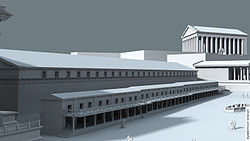 A modern model of Basilica Sempronia | |
| Coordinates | 41°53′31″N12°29′06″E / 41.891979°N 12.484884°E |
|---|---|
| Type | Basilica |
| History | |
| Builder | Tiberius Sempronius Gracchus |
| Founded | 169 BC |
The Basilica Sempronia was a structure in the Roman Forum during the Republican period. [1] It was one of four basilicas to make up the original Roman Forum alongside the Basilica Porcia, Basilica Aemilia, and Basilica Opimia, and was the third built. [2] Although excavations have revealed remains of the basilica as well as the structures that originally stood in its place, none of them are visible from the Roman Forum. [3] [4]


